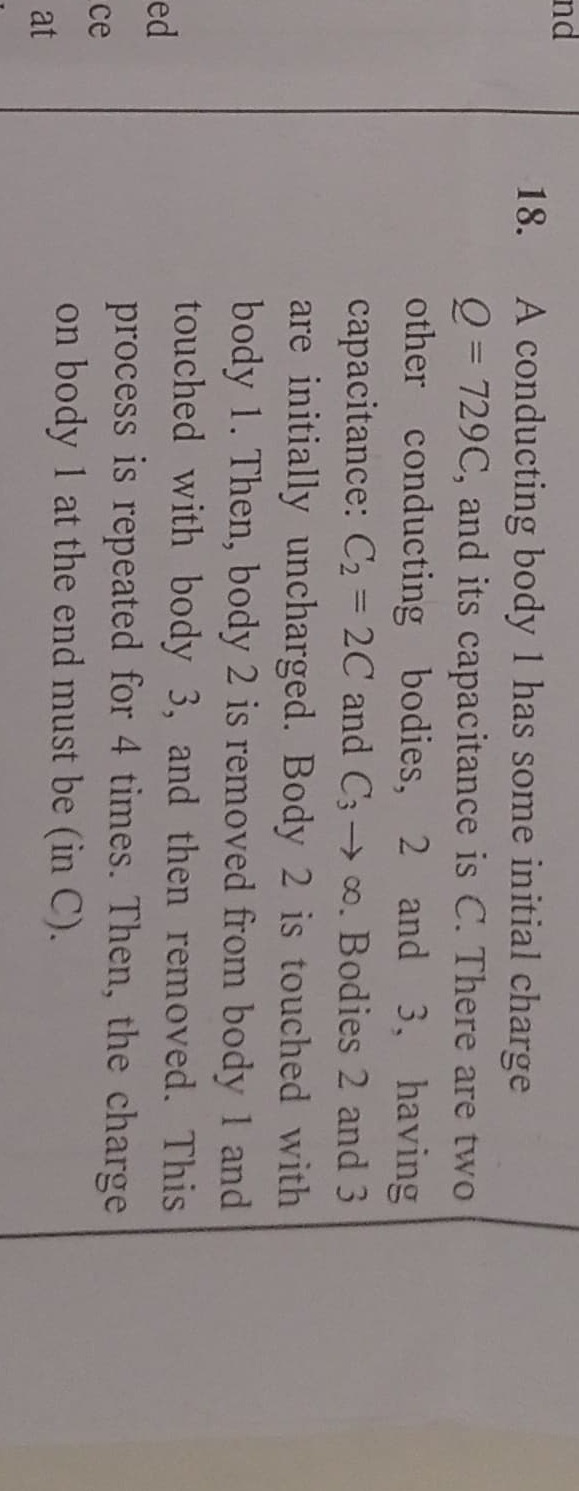Question
Question: A conducting body 1 has some initial charge $Q = 729C$, and its capacitance is C. There are two othe...
A conducting body 1 has some initial charge Q=729C, and its capacitance is C. There are two other conducting bodies, 2 and 3, having capacitance: C2=2C and C3→∞. Bodies 2 and 3 are initially uncharged. Body 2 is touched with body 1. Then, body 2 is removed from body 1 and touched with body 3, and then removed. This process is repeated for 4 times. Then, the charge on body 1 at the end must be (in C).

9
Solution
The problem describes a process of charge transfer between three conducting bodies. Let's denote the capacitances as C1=C, C2=2C, and C3→∞. The initial charge on body 1 is Q1(0)=729C, while bodies 2 and 3 are initially uncharged. The process is repeated 4 times.
Let's analyze one cycle of the process:
A. Body 2 is touched with body 1.
When two conducting bodies are touched, charge redistributes until they reach the same potential. The total charge is conserved.
Let Q1(n−1) be the charge on body 1 at the beginning of the n-th cycle, and body 2 is uncharged (Q2=0).
After touching, the new charges Q1′ and Q2′ will be:
Q1′=C1+C2C1(Q1(n−1)+Q2)
Q2′=C1+C2C2(Q1(n−1)+Q2)
Substituting the given values C1=C, C2=2C, and Q2=0:
Q1′=C+2CCQ1(n−1)=3CCQ1(n−1)=31Q1(n−1)
Q2′=C+2C2CQ1(n−1)=3C2CQ1(n−1)
So, after this step, body 1 has charge 31Q1(n−1) and body 2 has charge 32Q1(n−1).
B. Body 2 is removed from body 1 and touched with body 3.
Body 2 now carries charge Q2′=32Q1(n−1). Body 3 has infinite capacitance (C3→∞). When a charged body is touched to a body with infinite capacitance (like grounding), all its charge flows to the body with infinite capacitance, as its potential effectively remains zero.
Therefore, after touching body 3, the charge on body 2 becomes 0. The charge Q2′ is transferred to body 3.
The charge on body 1 is unaffected by this step, as body 2 has already been removed from it.
So, at the end of one complete cycle, the charge on body 1, Q1(n), is:
Q1(n)=Q1′=31Q1(n−1)
This means that in each cycle, the charge on body 1 becomes one-third of its charge at the beginning of that cycle.
The process is repeated for 4 times. We can find the charge on body 1 after 4 cycles:
Q1(1)=31Q1(0)
Q1(2)=31Q1(1)=(31)2Q1(0)
Q1(3)=31Q1(2)=(31)3Q1(0)
Q1(4)=31Q1(3)=(31)4Q1(0)
Given initial charge Q1(0)=729C.
Q1(4)=(31)4×729
We know that 34=81 and 729=36.
Q1(4)=811×729=3436=3(6−4)=32=9C.
The charge on body 1 at the end of 4 repetitions is 9C.
Explanation of the solution:
- Charge Distribution (Body 1 & 2): When body 1 (charge Q1, capacitance C) and body 2 (uncharged, capacitance 2C) are touched, the total charge Q1 redistributes. The charge on body 1 becomes Q1′=C+2CCQ1=31Q1. The charge on body 2 becomes Q2′=C+2C2CQ1=32Q1.
- Charge Transfer (Body 2 & 3): Body 2, now charged with Q2′, is touched to body 3 (infinite capacitance). All its charge Q2′ transfers to body 3, leaving body 2 uncharged (0). Body 1's charge remains Q1′.
- Recursive Relation: After one cycle, the charge on body 1 is Q1′=31Q1. This means the charge on body 1 is reduced by a factor of 3 in each cycle.
- Calculation: After 4 cycles, the charge on body 1 will be Q1(4)=(31)4Q1(0). Given Q1(0)=729C, Q1(4)=(31)4×729=811×729=9C.
